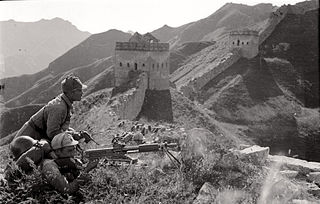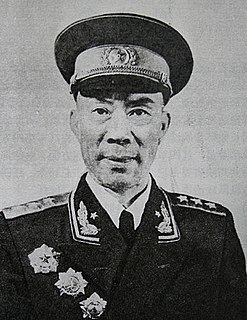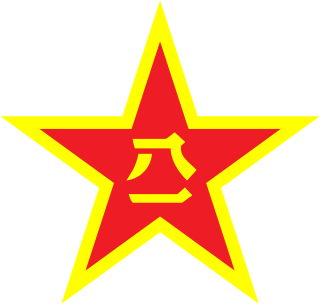Related Research Articles

The National Revolutionary Army, sometimes shortened to Revolutionary Army (革命軍) before 1928, and as National Army (國軍) after 1928, was the military arm of the Kuomintang from 1925 until 1947 in the Republic of China. It also became the regular army of the ROC during the KMT's period of party rule beginning in 1928. It was renamed the Republic of China Armed Forces after the 1947 Constitution, which instituted civilian control of the military.

The Republic of China Military Academy is the military academy for the army of the Republic of China, located in Fengshan District, Kaohsiung. Previously known as the Whampoa Military Academy, the military academy produced commanders who fought in many of China's conflicts in the 20th century, notably the Northern Expedition, the Second Sino-Japanese War and the Chinese Civil War.

The Eighth Route Army, officially known as the 18th Group Army of the National Revolutionary Army of the Republic of China, was a group army under the command of the Chinese Communist Party, nominally within the structure of the Chinese military headed by the Chinese Nationalist Party during the Second Sino-Japanese War.
The 40th Group Army was a military formation of the People's Liberation Army, active in various forms from 1949 to 2017. It was last located in the Shenyang Military Region and the Northern Theater Command.
The 7th Fighter Aviation Division is a unit of the Chinese People's Liberation Army Air Force. It is headquartered at Zhangjiakou Air Base in the Beijing Military Region. The unit is equipped with the Chengdu J-7 and Shenyang J-11 fighters. PLA-AF fighter divisions generally consist of about 17,000 personnel and 70-120 aircraft.
The 15th Fighter Aviation Division is a unit of the Chinese People's Liberation Army Air Force. It is headquartered at Huairen Air Base in the Beijing Military Region. The unit is equipped with J-7 fighters and Q-5 ground attack aircraft. PLA-AF fighter divisions generally consist of about 17,000 personnel and 70-120 aircraft.
The 24th Fighter Aviation Division is a unit of the Chinese People's Liberation Army Air Force. It is headquartered at Yangcun Air Base in the Beijing Military Region. The unit is equipped with J-8 fighters. PLA-AF fighter divisions generally consist of about 17,000 personnel and 70-120 aircraft.
The 1st Fighter Aviation Division is a military formation of the Chinese People's Liberation Army Air Force. It is headquartered at Anshan Air Base in the Shenyang Military Region. The unit is equipped with Chengdu J-10, Shenyang J-8 and Shenyang J-11 fighters. PLA-AF fighter divisions generally consist of about 17,000 personnel and 70-120 aircraft.

Zhang Zongxun was a general of the People's Liberation Army of China.

Zhou Shidi was a general of the People's Liberation Army of China.

The Battle of Unsan, also known as the Battle of Yunshan, was a series of engagements of the Korean War that took place from 25 October to 4 November 1950 near Unsan, North Pyongan province in present-day North Korea. As part of the People's Republic of China's First Phase Campaign, the People's Volunteer Army (PVA) made repeated attacks against the Republic of Korea Army (ROK) 1st Infantry Division near Unsan beginning on 25 October, in an attempt to take advancing United Nations forces by surprise. In an accidental first encounter with the United States military during the Korean War, the PVA 39th Corps attacked the unprepared US 8th Cavalry Regiment in Unsan on 1 November, resulting in one of the most devastating US losses of the Korean War.

The Battle of Onjong, also known as the Battle of Wenjing, was one of the first engagements between Chinese and United Nations (UN) forces during the Korean War. It took place around Onjong in present-day North Korea from 25 to 29 October 1950. As the main focus of the Chinese First Phase Offensive, the People's Volunteer Army (PVA) 40th Corps conducted a series of ambushes against the Republic of Korea Army (ROK) II Corps, effectively destroying the right flank of the United States Eighth Army while stopping the UN advance north toward the Yalu River.

The 72nd Group Army, formerly 1st Group Army, is a military formation of China's People's Liberation Army. It is one of three active group armies belonging to the Eastern Theater Command. The army is based at Huzhou, Zhejiang and is composed of the 1st Amphibious Mechanized Infantry Division, an armored division, an artillery division, a motorized infantry brigade, an engineer regiment and an air defense brigade. It is considered a Category A unit, with priority status in terms of readiness, strength, and modern equipment.

The 71st Group Army, formerly the 12th (Group) Army, was one of the three group armies of the Chinese People's Liberation Army's Eastern Theater Command.
Wang Jianping is a former general of the People's Liberation Army (PLA) of China. He served as Commander of the People's Armed Police and Deputy Chief of General Staff of the People's Liberation Army. He was dismissed in 2016 and placed under investigation for corruption. He was a member of the 18th Central Committee of the Communist Party of China.
The 7th Division (1st Formation) of the Chinese People's Liberation Army was created in February 1949 under the Regulation of the Redesignations of All Organizations and Units of the Army, issued by Central Military Commission on November 1, 1948, basing on the 2nd Independent Brigade, 3rd Column of the PLA Northwestern Field Army. Its history can be traced to the 358th Brigade(2nd Formation), 120th Division of Eighth Route Army, formed in April 1939.
The 55th Light Combined Arms Brigade, formerly the 55th Division, is a military formation of the People's Liberation Army Ground Force of the People's Republic of China. It is now one of six combined arms brigades of the PLA 77th Group Army.
The People's Liberation Army Air Force Airborne Corps is a corps directly under the People's Liberation Army Air Force (PLAAF) headquarters. It was reorganized and renamed from the 15th Airborne Corps in May 2017 and now comprises six airborne brigades and a special operations brigade. The PLAAF Airborne Corps is China's primary strategic airborne unit and part of the newly formed rapid reaction units (RRUs) of the Chinese military which is primarily designated for airborne and special operation missions. Its role is similar to that of the U.S. Army's XVIII Airborne Corps/82nd Airborne Division.
References
- ↑ Appleman, Roy E. (1992). "XXXIX The Big Question". South to the Naktong, North to the Yalu. United States Army Center of Military History. p. 768. CMH Pub 20-2-1.